A Report on Statistical Analysis of BMI and ROM Baseline in Athletes
VerifiedAdded on 2023/06/15
|9
|2421
|59
Report
AI Summary
This report investigates the statistical relationship between Body Mass Index (BMI) and Range of Motion (ROM) baseline using quantitative methods. Data was collected from 20 respondents, and analyzed using SPSS software, employing descriptive and inferential statistics, including regression analysis and chi-square tests. The study aimed to dete...
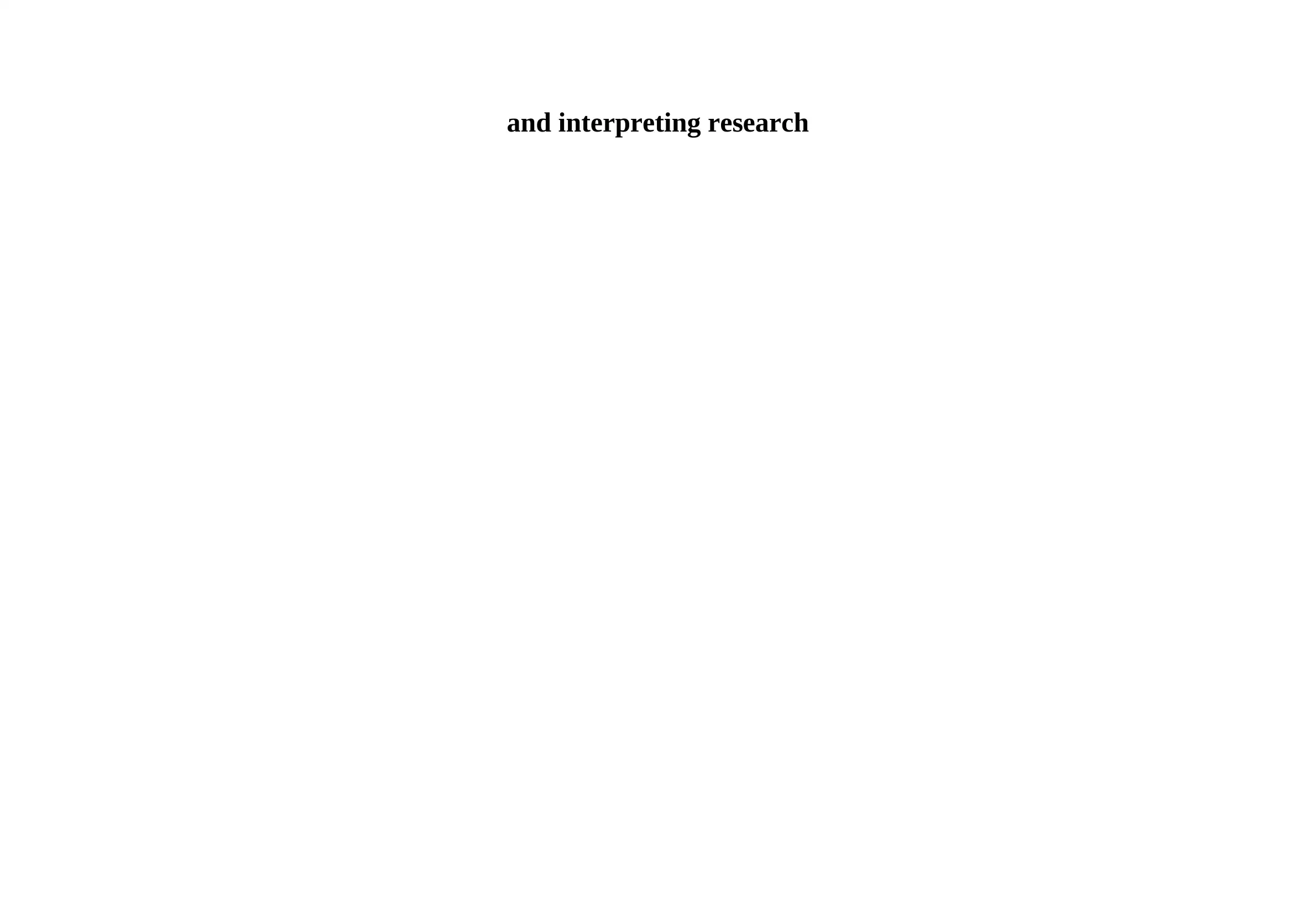
and interpreting research
Paraphrase This Document
Need a fresh take? Get an instant paraphrase of this document with our AI Paraphraser
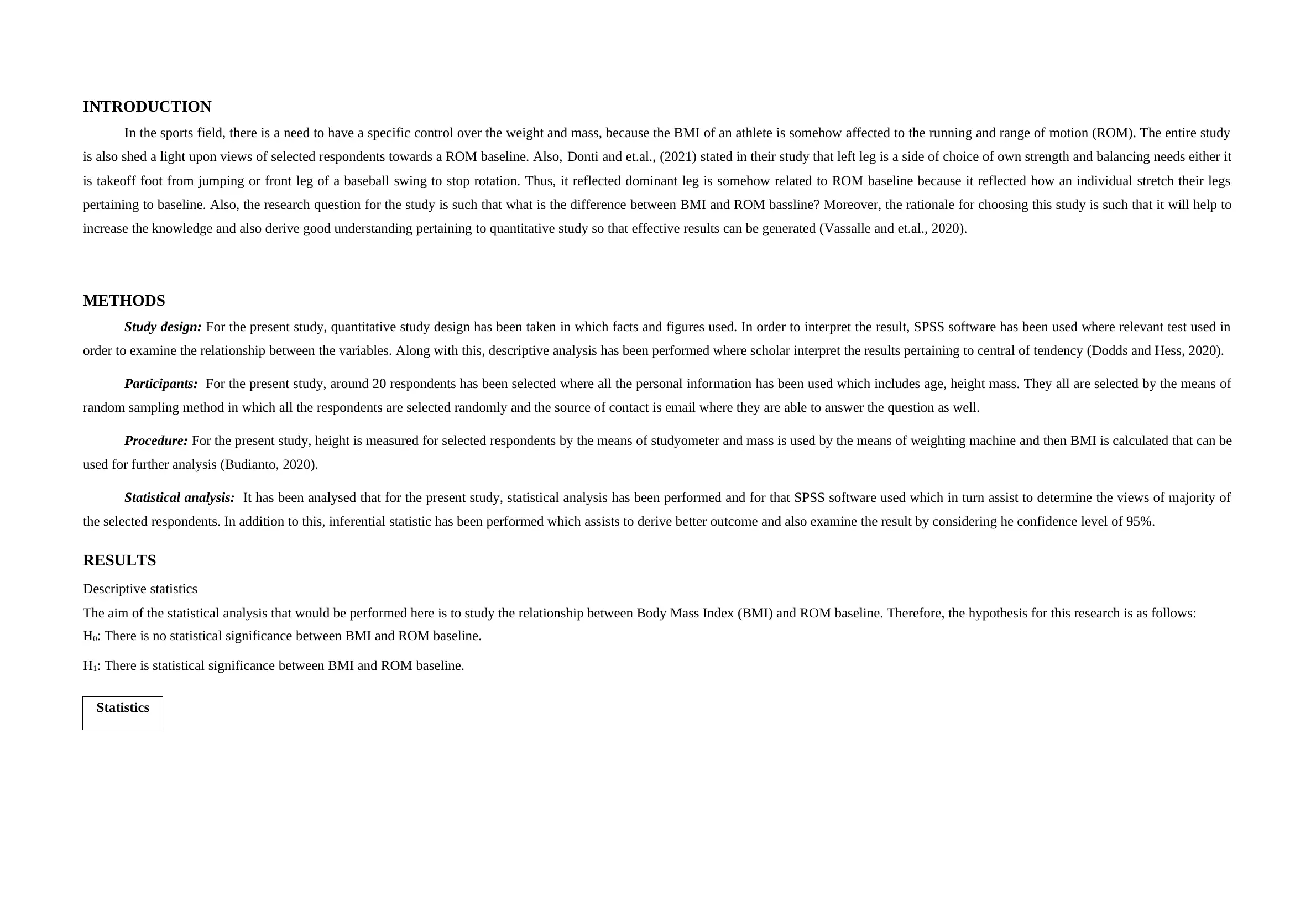
INTRODUCTION
In the sports field, there is a need to have a specific control over the weight and mass, because the BMI of an athlete is somehow affected to the running and range of motion (ROM). The entire study
is also shed a light upon views of selected respondents towards a ROM baseline. Also, Donti and et.al., (2021) stated in their study that left leg is a side of choice of own strength and balancing needs either it
is takeoff foot from jumping or front leg of a baseball swing to stop rotation. Thus, it reflected dominant leg is somehow related to ROM baseline because it reflected how an individual stretch their legs
pertaining to baseline. Also, the research question for the study is such that what is the difference between BMI and ROM bassline? Moreover, the rationale for choosing this study is such that it will help to
increase the knowledge and also derive good understanding pertaining to quantitative study so that effective results can be generated (Vassalle and et.al., 2020).
METHODS
Study design: For the present study, quantitative study design has been taken in which facts and figures used. In order to interpret the result, SPSS software has been used where relevant test used in
order to examine the relationship between the variables. Along with this, descriptive analysis has been performed where scholar interpret the results pertaining to central of tendency (Dodds and Hess, 2020).
Participants: For the present study, around 20 respondents has been selected where all the personal information has been used which includes age, height mass. They all are selected by the means of
random sampling method in which all the respondents are selected randomly and the source of contact is email where they are able to answer the question as well.
Procedure: For the present study, height is measured for selected respondents by the means of studyometer and mass is used by the means of weighting machine and then BMI is calculated that can be
used for further analysis (Budianto, 2020).
Statistical analysis: It has been analysed that for the present study, statistical analysis has been performed and for that SPSS software used which in turn assist to determine the views of majority of
the selected respondents. In addition to this, inferential statistic has been performed which assists to derive better outcome and also examine the result by considering he confidence level of 95%.
RESULTS
Descriptive statistics
The aim of the statistical analysis that would be performed here is to study the relationship between Body Mass Index (BMI) and ROM baseline. Therefore, the hypothesis for this research is as follows:
H0: There is no statistical significance between BMI and ROM baseline.
H1: There is statistical significance between BMI and ROM baseline.
Statistics
In the sports field, there is a need to have a specific control over the weight and mass, because the BMI of an athlete is somehow affected to the running and range of motion (ROM). The entire study
is also shed a light upon views of selected respondents towards a ROM baseline. Also, Donti and et.al., (2021) stated in their study that left leg is a side of choice of own strength and balancing needs either it
is takeoff foot from jumping or front leg of a baseball swing to stop rotation. Thus, it reflected dominant leg is somehow related to ROM baseline because it reflected how an individual stretch their legs
pertaining to baseline. Also, the research question for the study is such that what is the difference between BMI and ROM bassline? Moreover, the rationale for choosing this study is such that it will help to
increase the knowledge and also derive good understanding pertaining to quantitative study so that effective results can be generated (Vassalle and et.al., 2020).
METHODS
Study design: For the present study, quantitative study design has been taken in which facts and figures used. In order to interpret the result, SPSS software has been used where relevant test used in
order to examine the relationship between the variables. Along with this, descriptive analysis has been performed where scholar interpret the results pertaining to central of tendency (Dodds and Hess, 2020).
Participants: For the present study, around 20 respondents has been selected where all the personal information has been used which includes age, height mass. They all are selected by the means of
random sampling method in which all the respondents are selected randomly and the source of contact is email where they are able to answer the question as well.
Procedure: For the present study, height is measured for selected respondents by the means of studyometer and mass is used by the means of weighting machine and then BMI is calculated that can be
used for further analysis (Budianto, 2020).
Statistical analysis: It has been analysed that for the present study, statistical analysis has been performed and for that SPSS software used which in turn assist to determine the views of majority of
the selected respondents. In addition to this, inferential statistic has been performed which assists to derive better outcome and also examine the result by considering he confidence level of 95%.
RESULTS
Descriptive statistics
The aim of the statistical analysis that would be performed here is to study the relationship between Body Mass Index (BMI) and ROM baseline. Therefore, the hypothesis for this research is as follows:
H0: There is no statistical significance between BMI and ROM baseline.
H1: There is statistical significance between BMI and ROM baseline.
Statistics
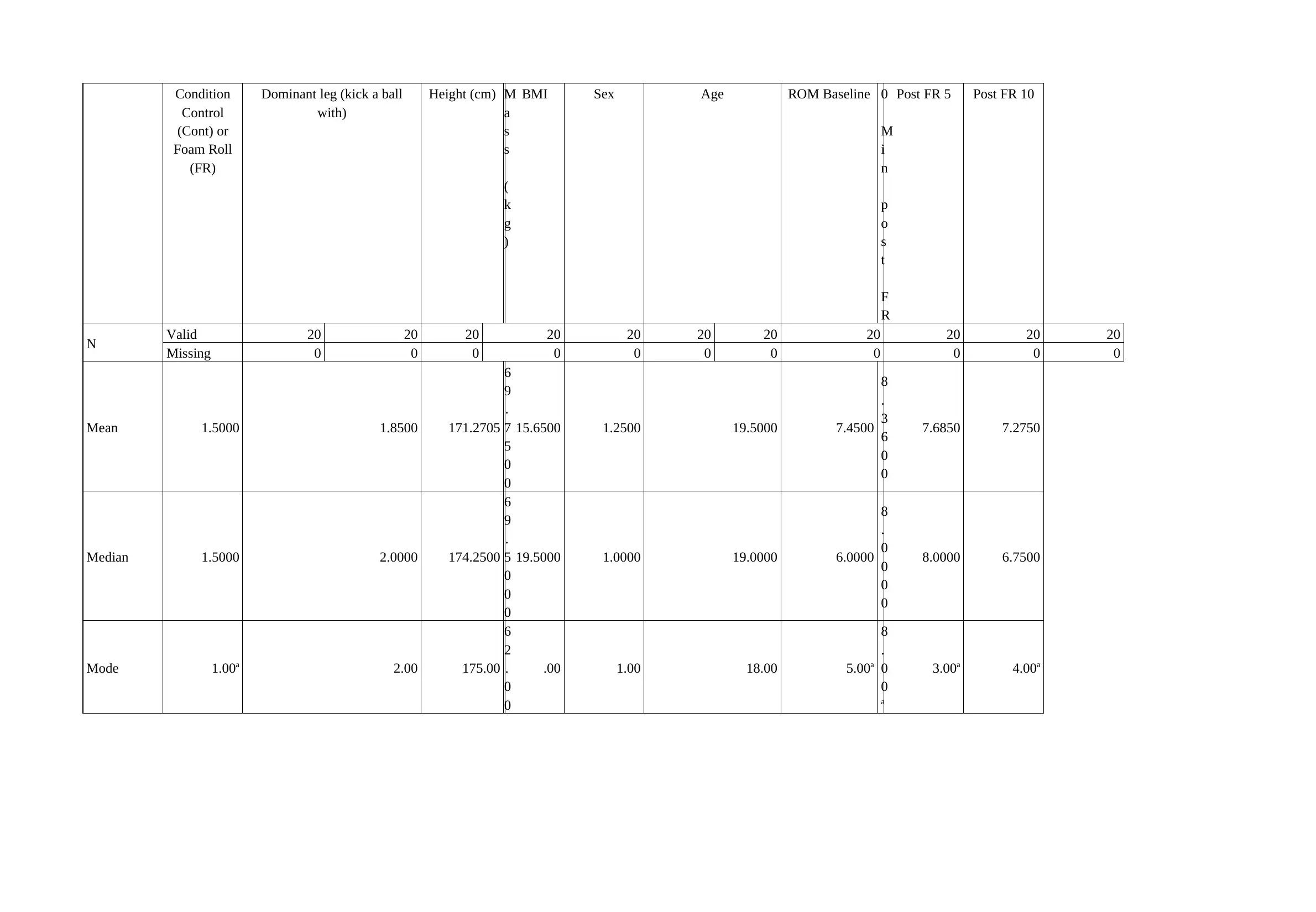
Condition
Control
(Cont) or
Foam Roll
(FR)
Dominant leg (kick a ball
with)
Height (cm) M
a
s
s
(
k
g
)
BMI Sex Age ROM Baseline 0
M
i
n
p
o
s
t
F
R
Post FR 5 Post FR 10
N Valid 20 20 20 20 20 20 20 20 20 20 20
Missing 0 0 0 0 0 0 0 0 0 0 0
Mean 1.5000 1.8500 171.2705
6
9
.
7
5
0
0
15.6500 1.2500 19.5000 7.4500
8
.
3
6
0
0
7.6850 7.2750
Median 1.5000 2.0000 174.2500
6
9
.
5
0
0
0
19.5000 1.0000 19.0000 6.0000
8
.
0
0
0
0
8.0000 6.7500
Mode 1.00a 2.00 175.00
6
2
.
0
0
.00 1.00 18.00 5.00a
8
.
0
0
a
3.00a 4.00a
Control
(Cont) or
Foam Roll
(FR)
Dominant leg (kick a ball
with)
Height (cm) M
a
s
s
(
k
g
)
BMI Sex Age ROM Baseline 0
M
i
n
p
o
s
t
F
R
Post FR 5 Post FR 10
N Valid 20 20 20 20 20 20 20 20 20 20 20
Missing 0 0 0 0 0 0 0 0 0 0 0
Mean 1.5000 1.8500 171.2705
6
9
.
7
5
0
0
15.6500 1.2500 19.5000 7.4500
8
.
3
6
0
0
7.6850 7.2750
Median 1.5000 2.0000 174.2500
6
9
.
5
0
0
0
19.5000 1.0000 19.0000 6.0000
8
.
0
0
0
0
8.0000 6.7500
Mode 1.00a 2.00 175.00
6
2
.
0
0
.00 1.00 18.00 5.00a
8
.
0
0
a
3.00a 4.00a
⊘ This is a preview!⊘
Do you want full access?
Subscribe today to unlock all pages.

Trusted by 1+ million students worldwide
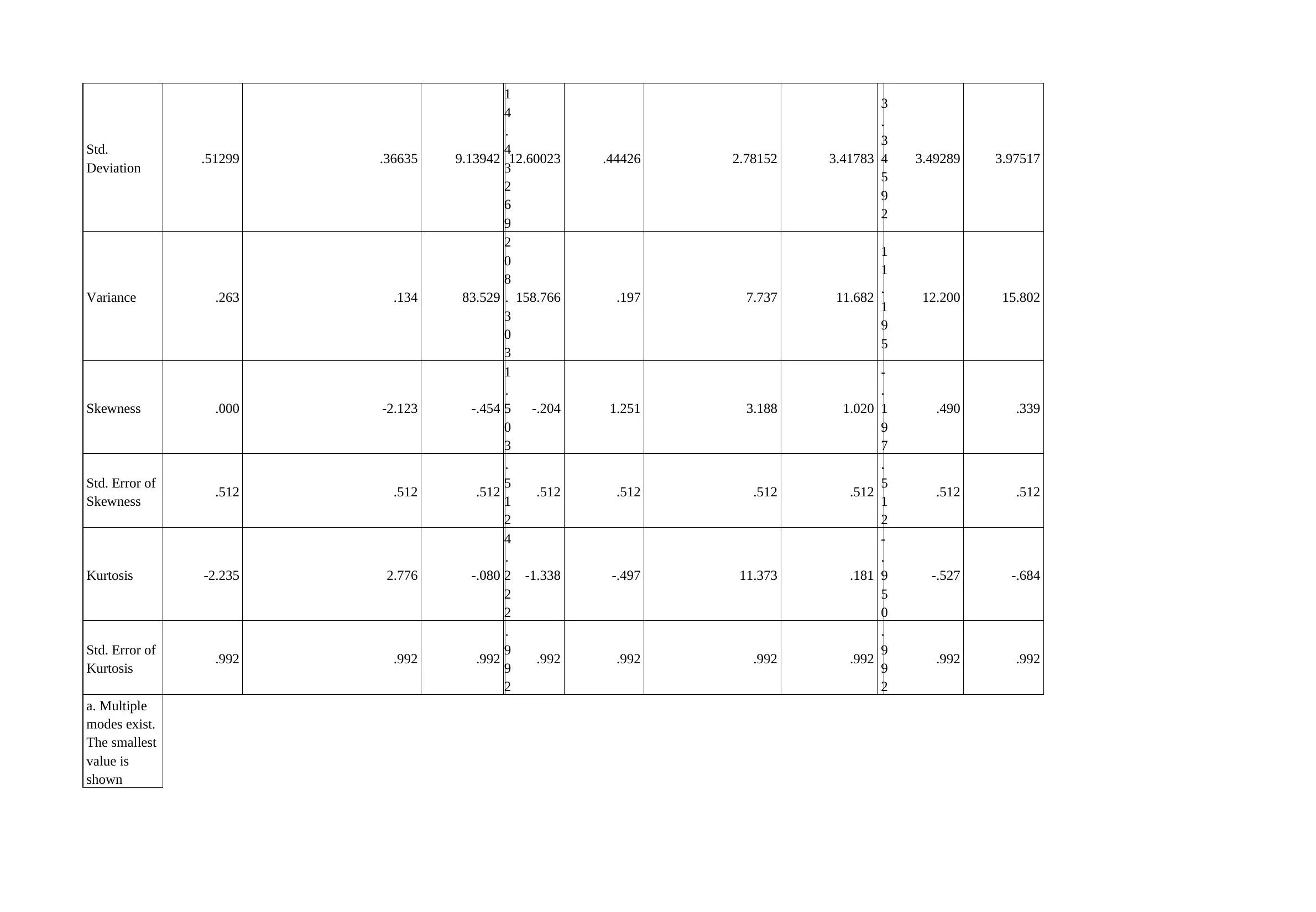
Std.
Deviation .51299 .36635 9.13942
1
4
.
4
3
2
6
9
12.60023 .44426 2.78152 3.41783
3
.
3
4
5
9
2
3.49289 3.97517
Variance .263 .134 83.529
2
0
8
.
3
0
3
158.766 .197 7.737 11.682
1
1
.
1
9
5
12.200 15.802
Skewness .000 -2.123 -.454
1
.
5
0
3
-.204 1.251 3.188 1.020
-
.
1
9
7
.490 .339
Std. Error of
Skewness .512 .512 .512
.
5
1
2
.512 .512 .512 .512
.
5
1
2
.512 .512
Kurtosis -2.235 2.776 -.080
4
.
2
2
2
-1.338 -.497 11.373 .181
-
.
9
5
0
-.527 -.684
Std. Error of
Kurtosis .992 .992 .992
.
9
9
2
.992 .992 .992 .992
.
9
9
2
.992 .992
a. Multiple
modes exist.
The smallest
value is
shown
Deviation .51299 .36635 9.13942
1
4
.
4
3
2
6
9
12.60023 .44426 2.78152 3.41783
3
.
3
4
5
9
2
3.49289 3.97517
Variance .263 .134 83.529
2
0
8
.
3
0
3
158.766 .197 7.737 11.682
1
1
.
1
9
5
12.200 15.802
Skewness .000 -2.123 -.454
1
.
5
0
3
-.204 1.251 3.188 1.020
-
.
1
9
7
.490 .339
Std. Error of
Skewness .512 .512 .512
.
5
1
2
.512 .512 .512 .512
.
5
1
2
.512 .512
Kurtosis -2.235 2.776 -.080
4
.
2
2
2
-1.338 -.497 11.373 .181
-
.
9
5
0
-.527 -.684
Std. Error of
Kurtosis .992 .992 .992
.
9
9
2
.992 .992 .992 .992
.
9
9
2
.992 .992
a. Multiple
modes exist.
The smallest
value is
shown
Paraphrase This Document
Need a fresh take? Get an instant paraphrase of this document with our AI Paraphraser
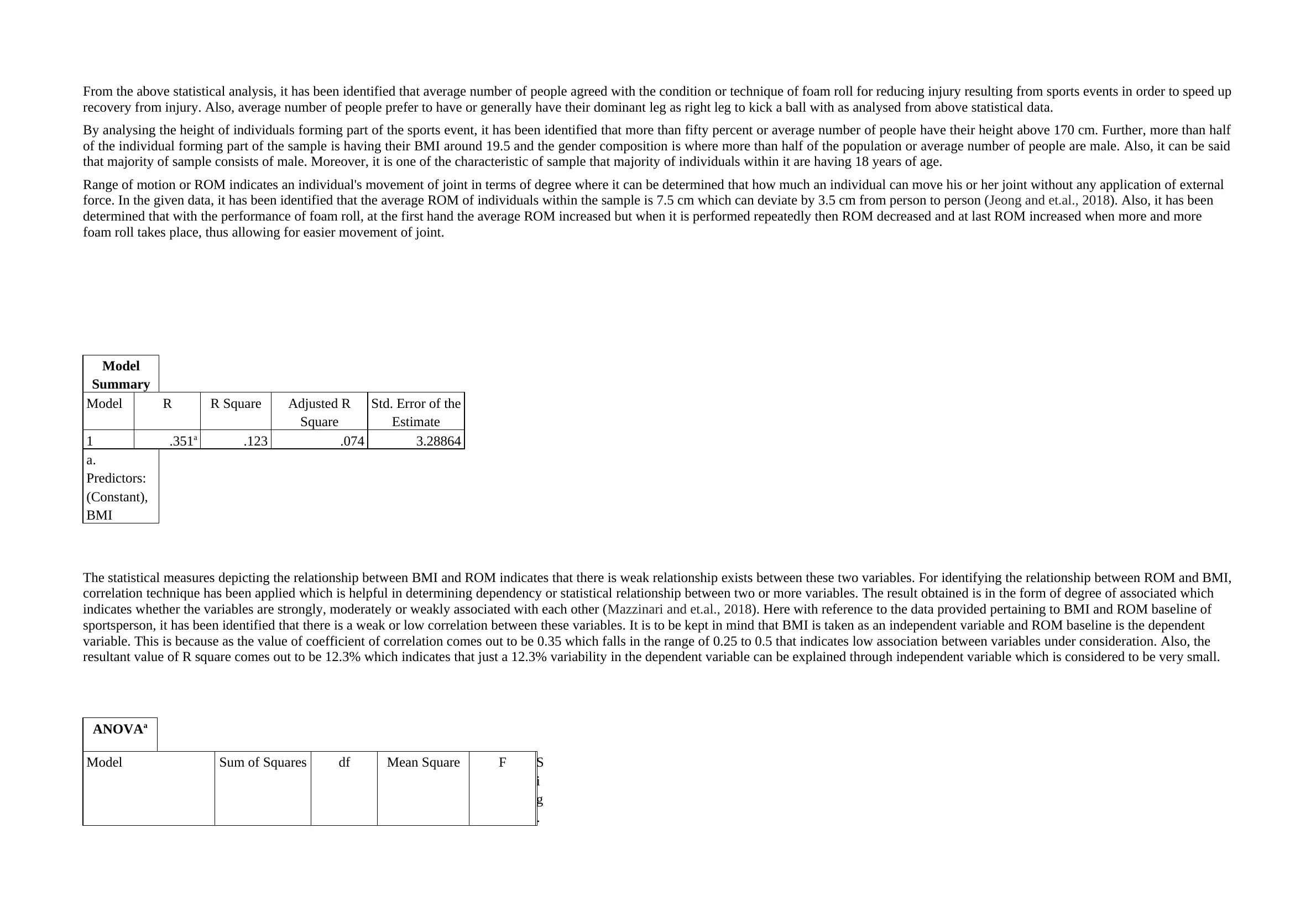
From the above statistical analysis, it has been identified that average number of people agreed with the condition or technique of foam roll for reducing injury resulting from sports events in order to speed up
recovery from injury. Also, average number of people prefer to have or generally have their dominant leg as right leg to kick a ball with as analysed from above statistical data.
By analysing the height of individuals forming part of the sports event, it has been identified that more than fifty percent or average number of people have their height above 170 cm. Further, more than half
of the individual forming part of the sample is having their BMI around 19.5 and the gender composition is where more than half of the population or average number of people are male. Also, it can be said
that majority of sample consists of male. Moreover, it is one of the characteristic of sample that majority of individuals within it are having 18 years of age.
Range of motion or ROM indicates an individual's movement of joint in terms of degree where it can be determined that how much an individual can move his or her joint without any application of external
force. In the given data, it has been identified that the average ROM of individuals within the sample is 7.5 cm which can deviate by 3.5 cm from person to person (Jeong and et.al., 2018). Also, it has been
determined that with the performance of foam roll, at the first hand the average ROM increased but when it is performed repeatedly then ROM decreased and at last ROM increased when more and more
foam roll takes place, thus allowing for easier movement of joint.
Model
Summary
Model R R Square Adjusted R
Square
Std. Error of the
Estimate
1 .351a .123 .074 3.28864
a.
Predictors:
(Constant),
BMI
The statistical measures depicting the relationship between BMI and ROM indicates that there is weak relationship exists between these two variables. For identifying the relationship between ROM and BMI,
correlation technique has been applied which is helpful in determining dependency or statistical relationship between two or more variables. The result obtained is in the form of degree of associated which
indicates whether the variables are strongly, moderately or weakly associated with each other (Mazzinari and et.al., 2018). Here with reference to the data provided pertaining to BMI and ROM baseline of
sportsperson, it has been identified that there is a weak or low correlation between these variables. It is to be kept in mind that BMI is taken as an independent variable and ROM baseline is the dependent
variable. This is because as the value of coefficient of correlation comes out to be 0.35 which falls in the range of 0.25 to 0.5 that indicates low association between variables under consideration. Also, the
resultant value of R square comes out to be 12.3% which indicates that just a 12.3% variability in the dependent variable can be explained through independent variable which is considered to be very small.
ANOVAa
Model Sum of Squares df Mean Square F S
i
g
.
recovery from injury. Also, average number of people prefer to have or generally have their dominant leg as right leg to kick a ball with as analysed from above statistical data.
By analysing the height of individuals forming part of the sports event, it has been identified that more than fifty percent or average number of people have their height above 170 cm. Further, more than half
of the individual forming part of the sample is having their BMI around 19.5 and the gender composition is where more than half of the population or average number of people are male. Also, it can be said
that majority of sample consists of male. Moreover, it is one of the characteristic of sample that majority of individuals within it are having 18 years of age.
Range of motion or ROM indicates an individual's movement of joint in terms of degree where it can be determined that how much an individual can move his or her joint without any application of external
force. In the given data, it has been identified that the average ROM of individuals within the sample is 7.5 cm which can deviate by 3.5 cm from person to person (Jeong and et.al., 2018). Also, it has been
determined that with the performance of foam roll, at the first hand the average ROM increased but when it is performed repeatedly then ROM decreased and at last ROM increased when more and more
foam roll takes place, thus allowing for easier movement of joint.
Model
Summary
Model R R Square Adjusted R
Square
Std. Error of the
Estimate
1 .351a .123 .074 3.28864
a.
Predictors:
(Constant),
BMI
The statistical measures depicting the relationship between BMI and ROM indicates that there is weak relationship exists between these two variables. For identifying the relationship between ROM and BMI,
correlation technique has been applied which is helpful in determining dependency or statistical relationship between two or more variables. The result obtained is in the form of degree of associated which
indicates whether the variables are strongly, moderately or weakly associated with each other (Mazzinari and et.al., 2018). Here with reference to the data provided pertaining to BMI and ROM baseline of
sportsperson, it has been identified that there is a weak or low correlation between these variables. It is to be kept in mind that BMI is taken as an independent variable and ROM baseline is the dependent
variable. This is because as the value of coefficient of correlation comes out to be 0.35 which falls in the range of 0.25 to 0.5 that indicates low association between variables under consideration. Also, the
resultant value of R square comes out to be 12.3% which indicates that just a 12.3% variability in the dependent variable can be explained through independent variable which is considered to be very small.
ANOVAa
Model Sum of Squares df Mean Square F S
i
g
.
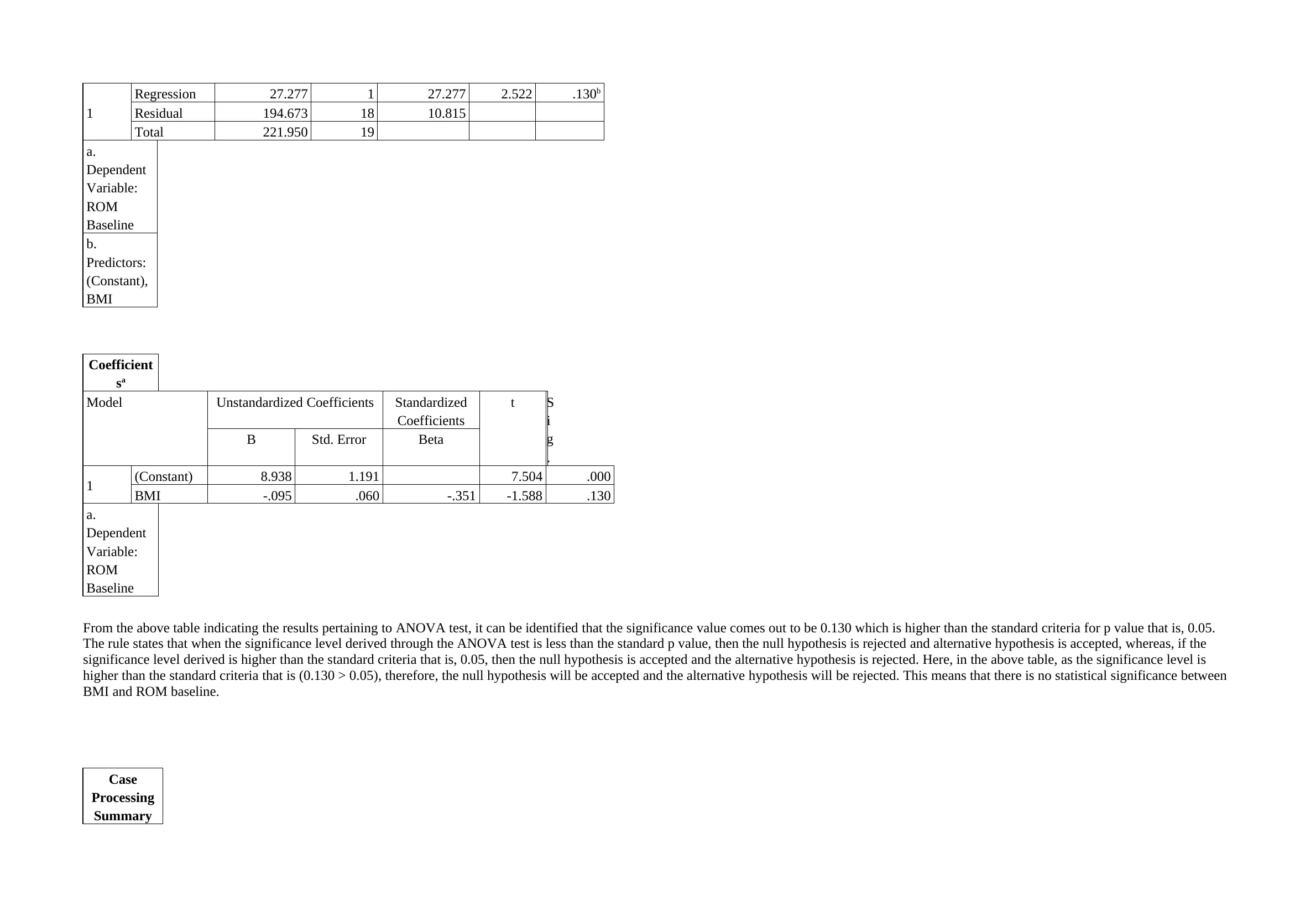
1
Regression 27.277 1 27.277 2.522 .130b
Residual 194.673 18 10.815
Total 221.950 19
a.
Dependent
Variable:
ROM
Baseline
b.
Predictors:
(Constant),
BMI
Coefficient
sa
Model Unstandardized Coefficients Standardized
Coefficients
t S
i
g
.
B Std. Error Beta
1 (Constant) 8.938 1.191 7.504 .000
BMI -.095 .060 -.351 -1.588 .130
a.
Dependent
Variable:
ROM
Baseline
From the above table indicating the results pertaining to ANOVA test, it can be identified that the significance value comes out to be 0.130 which is higher than the standard criteria for p value that is, 0.05.
The rule states that when the significance level derived through the ANOVA test is less than the standard p value, then the null hypothesis is rejected and alternative hypothesis is accepted, whereas, if the
significance level derived is higher than the standard criteria that is, 0.05, then the null hypothesis is accepted and the alternative hypothesis is rejected. Here, in the above table, as the significance level is
higher than the standard criteria that is (0.130 > 0.05), therefore, the null hypothesis will be accepted and the alternative hypothesis will be rejected. This means that there is no statistical significance between
BMI and ROM baseline.
Case
Processing
Summary
Regression 27.277 1 27.277 2.522 .130b
Residual 194.673 18 10.815
Total 221.950 19
a.
Dependent
Variable:
ROM
Baseline
b.
Predictors:
(Constant),
BMI
Coefficient
sa
Model Unstandardized Coefficients Standardized
Coefficients
t S
i
g
.
B Std. Error Beta
1 (Constant) 8.938 1.191 7.504 .000
BMI -.095 .060 -.351 -1.588 .130
a.
Dependent
Variable:
ROM
Baseline
From the above table indicating the results pertaining to ANOVA test, it can be identified that the significance value comes out to be 0.130 which is higher than the standard criteria for p value that is, 0.05.
The rule states that when the significance level derived through the ANOVA test is less than the standard p value, then the null hypothesis is rejected and alternative hypothesis is accepted, whereas, if the
significance level derived is higher than the standard criteria that is, 0.05, then the null hypothesis is accepted and the alternative hypothesis is rejected. Here, in the above table, as the significance level is
higher than the standard criteria that is (0.130 > 0.05), therefore, the null hypothesis will be accepted and the alternative hypothesis will be rejected. This means that there is no statistical significance between
BMI and ROM baseline.
Case
Processing
Summary
⊘ This is a preview!⊘
Do you want full access?
Subscribe today to unlock all pages.

Trusted by 1+ million students worldwide
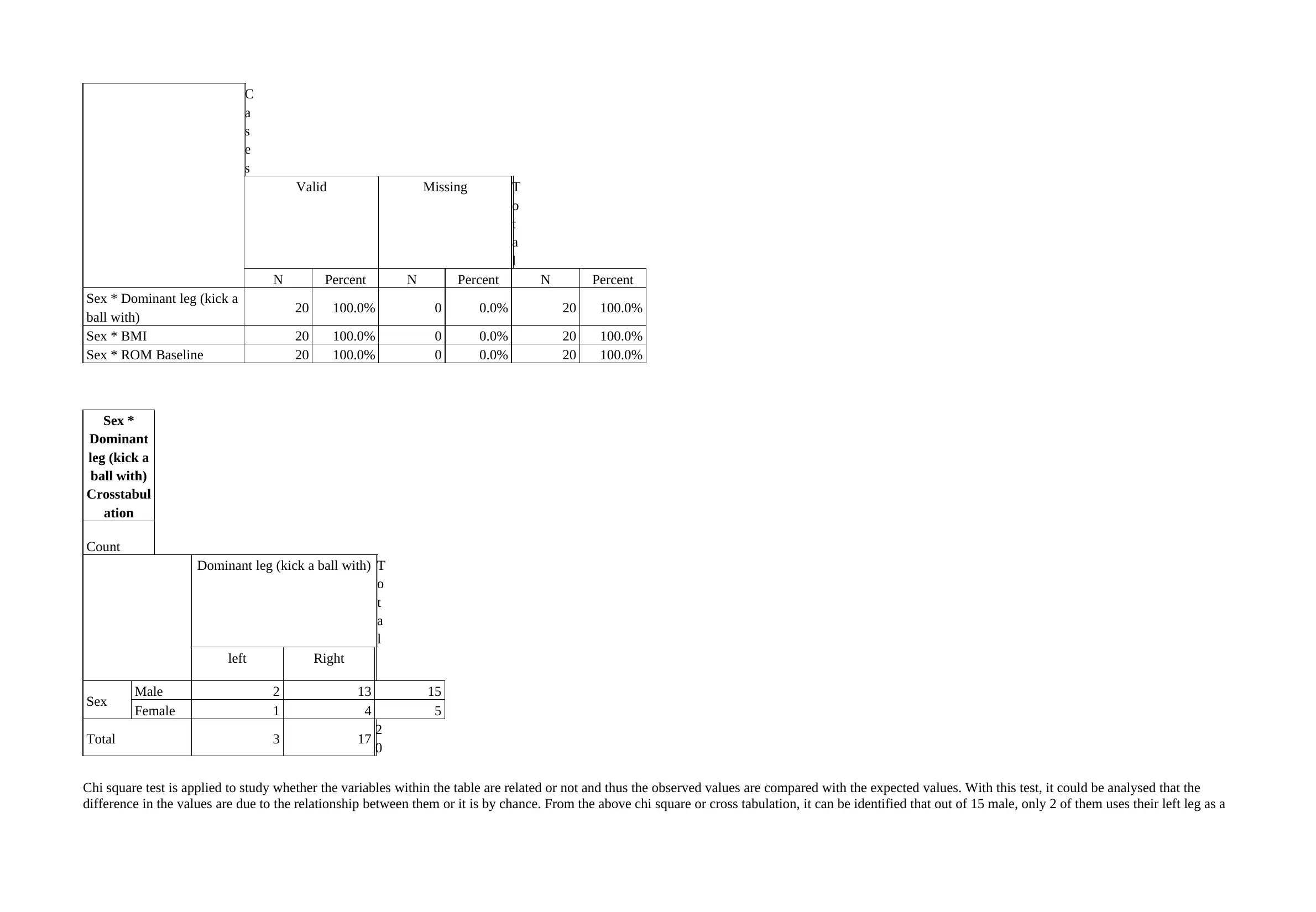
C
a
s
e
s
Valid Missing T
o
t
a
l
N Percent N Percent N Percent
Sex * Dominant leg (kick a
ball with) 20 100.0% 0 0.0% 20 100.0%
Sex * BMI 20 100.0% 0 0.0% 20 100.0%
Sex * ROM Baseline 20 100.0% 0 0.0% 20 100.0%
Sex *
Dominant
leg (kick a
ball with)
Crosstabul
ation
Count
Dominant leg (kick a ball with) T
o
t
a
l
left Right
Sex Male 2 13 15
Female 1 4 5
Total 3 17 2
0
Chi square test is applied to study whether the variables within the table are related or not and thus the observed values are compared with the expected values. With this test, it could be analysed that the
difference in the values are due to the relationship between them or it is by chance. From the above chi square or cross tabulation, it can be identified that out of 15 male, only 2 of them uses their left leg as a
a
s
e
s
Valid Missing T
o
t
a
l
N Percent N Percent N Percent
Sex * Dominant leg (kick a
ball with) 20 100.0% 0 0.0% 20 100.0%
Sex * BMI 20 100.0% 0 0.0% 20 100.0%
Sex * ROM Baseline 20 100.0% 0 0.0% 20 100.0%
Sex *
Dominant
leg (kick a
ball with)
Crosstabul
ation
Count
Dominant leg (kick a ball with) T
o
t
a
l
left Right
Sex Male 2 13 15
Female 1 4 5
Total 3 17 2
0
Chi square test is applied to study whether the variables within the table are related or not and thus the observed values are compared with the expected values. With this test, it could be analysed that the
difference in the values are due to the relationship between them or it is by chance. From the above chi square or cross tabulation, it can be identified that out of 15 male, only 2 of them uses their left leg as a
Paraphrase This Document
Need a fresh take? Get an instant paraphrase of this document with our AI Paraphraser
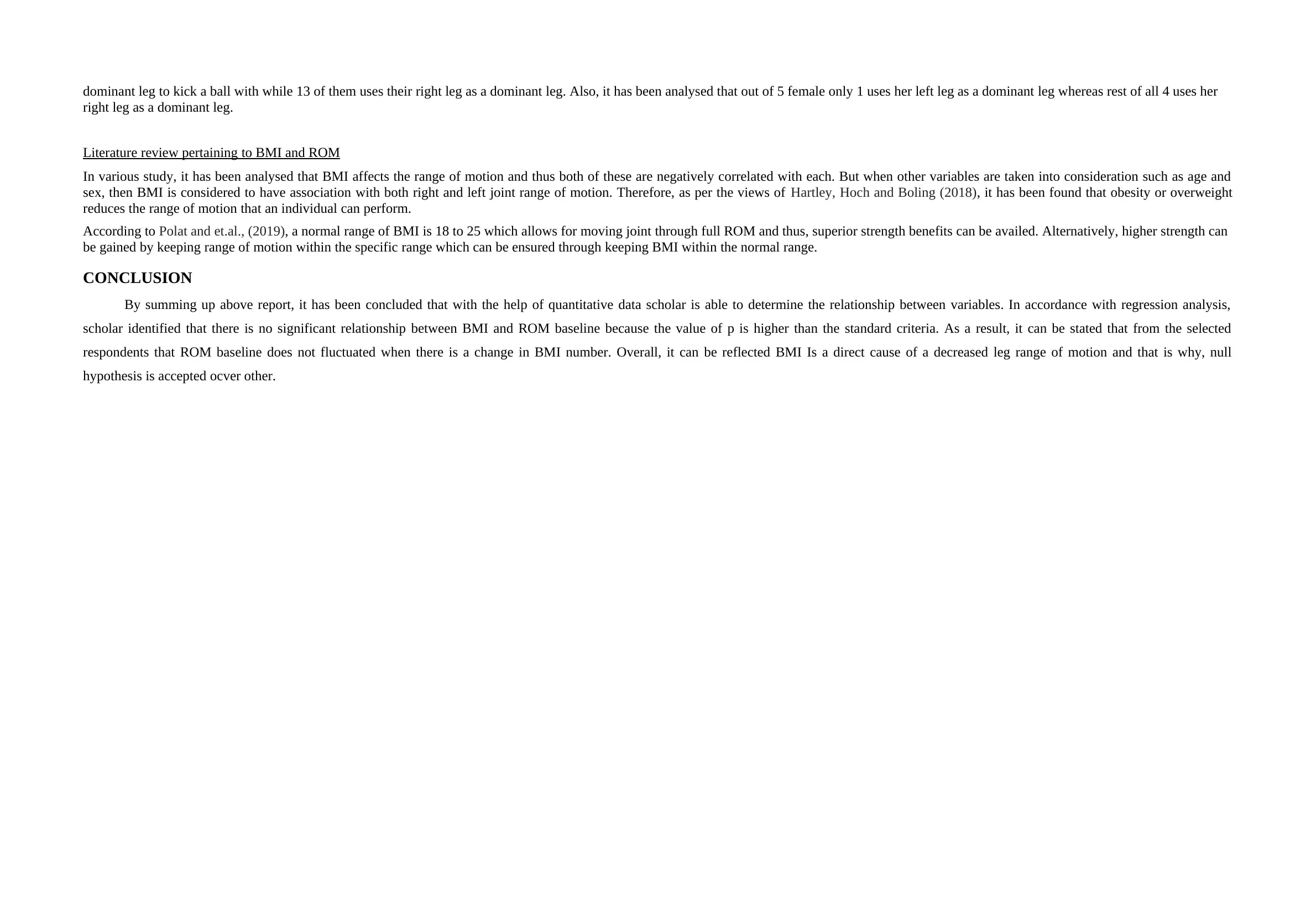
dominant leg to kick a ball with while 13 of them uses their right leg as a dominant leg. Also, it has been analysed that out of 5 female only 1 uses her left leg as a dominant leg whereas rest of all 4 uses her
right leg as a dominant leg.
Literature review pertaining to BMI and ROM
In various study, it has been analysed that BMI affects the range of motion and thus both of these are negatively correlated with each. But when other variables are taken into consideration such as age and
sex, then BMI is considered to have association with both right and left joint range of motion. Therefore, as per the views of Hartley, Hoch and Boling (2018), it has been found that obesity or overweight
reduces the range of motion that an individual can perform.
According to Polat and et.al., (2019), a normal range of BMI is 18 to 25 which allows for moving joint through full ROM and thus, superior strength benefits can be availed. Alternatively, higher strength can
be gained by keeping range of motion within the specific range which can be ensured through keeping BMI within the normal range.
CONCLUSION
By summing up above report, it has been concluded that with the help of quantitative data scholar is able to determine the relationship between variables. In accordance with regression analysis,
scholar identified that there is no significant relationship between BMI and ROM baseline because the value of p is higher than the standard criteria. As a result, it can be stated that from the selected
respondents that ROM baseline does not fluctuated when there is a change in BMI number. Overall, it can be reflected BMI Is a direct cause of a decreased leg range of motion and that is why, null
hypothesis is accepted ocver other.
right leg as a dominant leg.
Literature review pertaining to BMI and ROM
In various study, it has been analysed that BMI affects the range of motion and thus both of these are negatively correlated with each. But when other variables are taken into consideration such as age and
sex, then BMI is considered to have association with both right and left joint range of motion. Therefore, as per the views of Hartley, Hoch and Boling (2018), it has been found that obesity or overweight
reduces the range of motion that an individual can perform.
According to Polat and et.al., (2019), a normal range of BMI is 18 to 25 which allows for moving joint through full ROM and thus, superior strength benefits can be availed. Alternatively, higher strength can
be gained by keeping range of motion within the specific range which can be ensured through keeping BMI within the normal range.
CONCLUSION
By summing up above report, it has been concluded that with the help of quantitative data scholar is able to determine the relationship between variables. In accordance with regression analysis,
scholar identified that there is no significant relationship between BMI and ROM baseline because the value of p is higher than the standard criteria. As a result, it can be stated that from the selected
respondents that ROM baseline does not fluctuated when there is a change in BMI number. Overall, it can be reflected BMI Is a direct cause of a decreased leg range of motion and that is why, null
hypothesis is accepted ocver other.
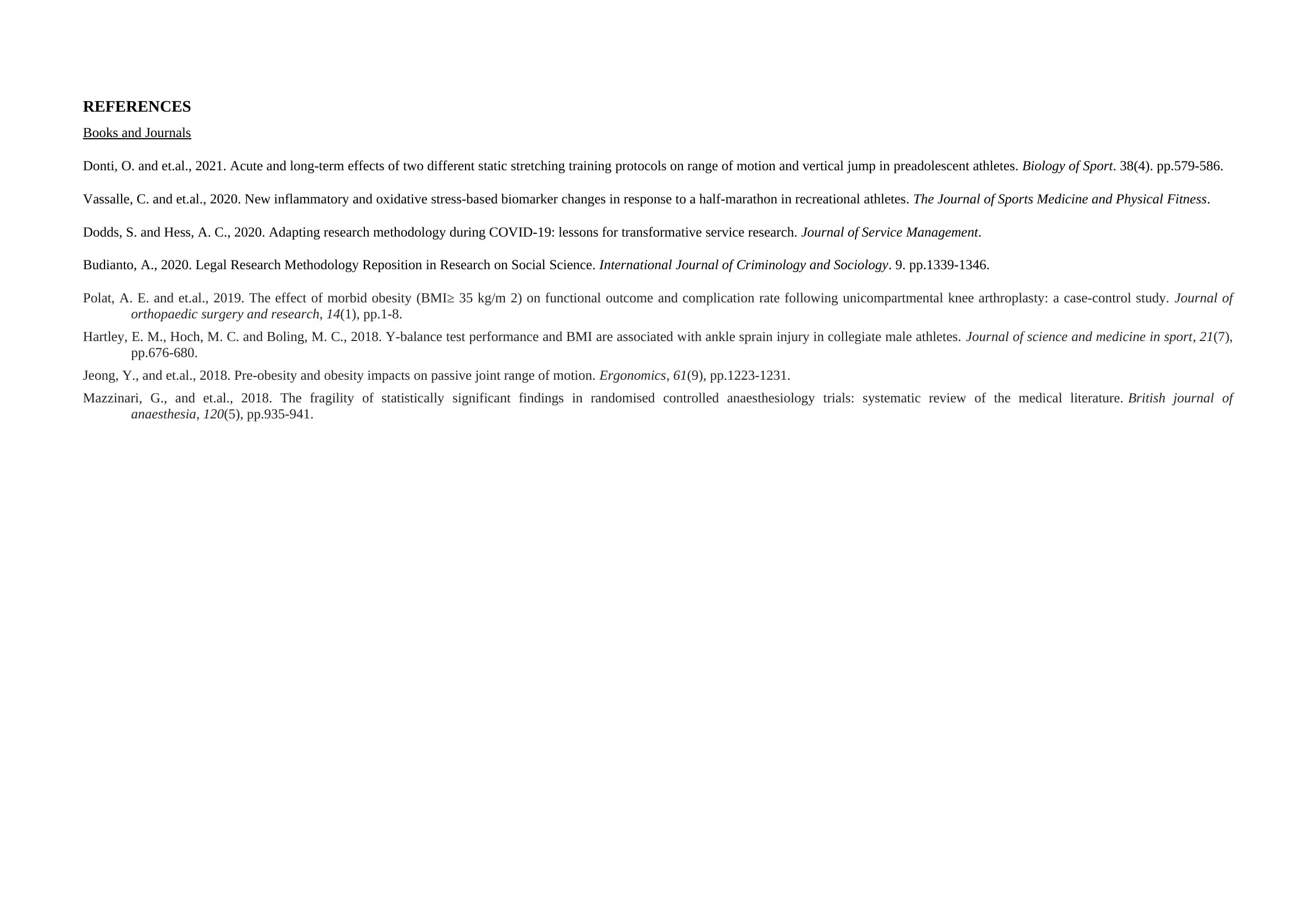
REFERENCES
Books and Journals
Donti, O. and et.al., 2021. Αcute and long-term effects of two different static stretching training protocols on range of motion and vertical jump in preadolescent athletes. Biology of Sport. 38(4). pp.579-586.
Vassalle, C. and et.al., 2020. New inflammatory and oxidative stress-based biomarker changes in response to a half-marathon in recreational athletes. The Journal of Sports Medicine and Physical Fitness.
Dodds, S. and Hess, A. C., 2020. Adapting research methodology during COVID-19: lessons for transformative service research. Journal of Service Management.
Budianto, A., 2020. Legal Research Methodology Reposition in Research on Social Science. International Journal of Criminology and Sociology. 9. pp.1339-1346.
Polat, A. E. and et.al., 2019. The effect of morbid obesity (BMI≥ 35 kg/m 2) on functional outcome and complication rate following unicompartmental knee arthroplasty: a case-control study. Journal of
orthopaedic surgery and research, 14(1), pp.1-8.
Hartley, E. M., Hoch, M. C. and Boling, M. C., 2018. Y-balance test performance and BMI are associated with ankle sprain injury in collegiate male athletes. Journal of science and medicine in sport, 21(7),
pp.676-680.
Jeong, Y., and et.al., 2018. Pre-obesity and obesity impacts on passive joint range of motion. Ergonomics, 61(9), pp.1223-1231.
Mazzinari, G., and et.al., 2018. The fragility of statistically significant findings in randomised controlled anaesthesiology trials: systematic review of the medical literature. British journal of
anaesthesia, 120(5), pp.935-941.
Books and Journals
Donti, O. and et.al., 2021. Αcute and long-term effects of two different static stretching training protocols on range of motion and vertical jump in preadolescent athletes. Biology of Sport. 38(4). pp.579-586.
Vassalle, C. and et.al., 2020. New inflammatory and oxidative stress-based biomarker changes in response to a half-marathon in recreational athletes. The Journal of Sports Medicine and Physical Fitness.
Dodds, S. and Hess, A. C., 2020. Adapting research methodology during COVID-19: lessons for transformative service research. Journal of Service Management.
Budianto, A., 2020. Legal Research Methodology Reposition in Research on Social Science. International Journal of Criminology and Sociology. 9. pp.1339-1346.
Polat, A. E. and et.al., 2019. The effect of morbid obesity (BMI≥ 35 kg/m 2) on functional outcome and complication rate following unicompartmental knee arthroplasty: a case-control study. Journal of
orthopaedic surgery and research, 14(1), pp.1-8.
Hartley, E. M., Hoch, M. C. and Boling, M. C., 2018. Y-balance test performance and BMI are associated with ankle sprain injury in collegiate male athletes. Journal of science and medicine in sport, 21(7),
pp.676-680.
Jeong, Y., and et.al., 2018. Pre-obesity and obesity impacts on passive joint range of motion. Ergonomics, 61(9), pp.1223-1231.
Mazzinari, G., and et.al., 2018. The fragility of statistically significant findings in randomised controlled anaesthesiology trials: systematic review of the medical literature. British journal of
anaesthesia, 120(5), pp.935-941.
⊘ This is a preview!⊘
Do you want full access?
Subscribe today to unlock all pages.

Trusted by 1+ million students worldwide
1 out of 9
Related Documents
Your All-in-One AI-Powered Toolkit for Academic Success.
+13062052269
info@desklib.com
Available 24*7 on WhatsApp / Email
![[object Object]](/_next/static/media/star-bottom.7253800d.svg)
Unlock your academic potential
© 2024 | Zucol Services PVT LTD | All rights reserved.





